Old Fashioned German Chocolate Cake Icing is a timeless delight that brings a touch of nostalgia and flavor to any chocolate cake, and at mens-fashion.net, we believe mastering this classic is a must for the modern man who appreciates the finer things. This isn’t just about baking; it’s about creating an experience. Elevate your dessert game with our comprehensive guide, and discover why this vintage frosting recipe is a cut above the rest. Explore flavor profiles, ingredient insights, and pairing suggestions that complement your style, and discover why it remains a beloved choice.
1. What Makes Old Fashioned German Chocolate Cake Icing So Special?
Old fashioned German chocolate cake icing distinguishes itself through a unique blend of rich flavors and a distinctive texture that modern frostings often miss. This classic recipe typically includes ingredients like evaporated milk, egg yolks, sugar, butter (or margarine), vanilla extract, shredded coconut, and pecans, creating a luscious, creamy topping. What sets it apart is the cooking process; the ingredients are combined and cooked on the stovetop until thickened, which develops a deep, caramelized flavor profile.
Here’s a breakdown of what makes it special:
- Flavor Complexity: The combination of coconut and pecans gives it a nutty, tropical twist that complements the chocolate cake perfectly.
- Texture: Unlike smoother, butter-based frostings, old fashioned German chocolate icing has a slightly coarser texture from the coconut and pecans, adding a delightful contrast to the soft cake.
- Homemade Quality: It avoids the overly sweet or artificial taste found in many store-bought frostings, delivering a more authentic and comforting flavor.
- Nostalgia: For many, this icing evokes memories of family gatherings and traditional baking, adding an emotional connection to the dessert.
- Richness: The use of evaporated milk and egg yolks contributes to a rich, decadent taste that feels indulgent.
According to culinary historians, the original German chocolate cake, attributed to Samuel German, an American baker working for Baker’s Chocolate Company in the mid-19th century, did not initially include this specific coconut-pecan icing. However, the icing became intrinsically linked to the cake over time, cementing its place in American baking history.
For the modern man, understanding this classic recipe is more than just baking; it’s about appreciating culinary heritage. At mens-fashion.net, we encourage you to embrace this tradition and elevate your baking skills. Whether you’re hosting a sophisticated dinner party or simply want to impress, mastering old fashioned German chocolate cake icing is a surefire way to make a statement. It’s a nod to timeless elegance and impeccable taste, qualities we value and promote in all aspects of men’s lifestyle and fashion.
2. What Are The Essential Ingredients For Old Fashioned German Chocolate Cake Icing?
To create the quintessential old fashioned German chocolate cake icing, you’ll need a precise selection of ingredients that, when combined, deliver that unique flavor and texture. Here’s a breakdown of the essentials:
- Evaporated Milk: This provides a creamy base and a slightly caramelized flavor when cooked. Unlike regular milk, evaporated milk has a concentrated richness that is crucial for the icing’s texture and taste.
- Granulated Sugar: The sweetener of choice, granulated sugar, balances the richness of the other ingredients and contributes to the icing’s smooth consistency.
- Egg Yolks: These add richness, smoothness, and a subtle custardy flavor to the icing. They also act as a thickening agent when cooked.
- Butter (or Margarine): Butter provides a smooth, creamy texture and a rich flavor, while margarine can be used as a substitute for a slightly different flavor profile.
- Vanilla Extract: A touch of vanilla enhances the other flavors and adds a warm, aromatic note to the icing.
- Shredded Coconut: Sweetened or unsweetened shredded coconut is a key ingredient, providing a distinct texture and tropical flavor that defines German chocolate cake icing.
- Pecans: Chopped pecans add a nutty flavor and a satisfying crunch, complementing the sweetness of the coconut and the richness of the chocolate cake.
Here’s a detailed look at each ingredient’s role:
| Ingredient | Function | Notes |
|---|---|---|
| Evaporated Milk | Provides a creamy base, caramelizes during cooking | Use full-fat for the richest flavor; avoid sweetened condensed milk. |
| Granulated Sugar | Sweetens the icing, contributes to smooth texture | Adjust quantity based on desired sweetness level. |
| Egg Yolks | Adds richness, smoothness, and acts as a thickening agent | Use fresh, high-quality eggs for the best flavor and texture. |
| Butter | Provides creamy texture and rich flavor | Unsalted butter is preferable to control the salt level; margarine can be used as a substitute. |
| Vanilla Extract | Enhances flavors, adds a warm note | Use pure vanilla extract for the best flavor; avoid imitation vanilla. |
| Shredded Coconut | Provides distinct texture and tropical flavor | Sweetened coconut adds more sweetness; unsweetened allows better control of the overall sweetness. |
| Pecans | Adds nutty flavor and crunch | Toast pecans lightly before chopping to enhance their flavor. |
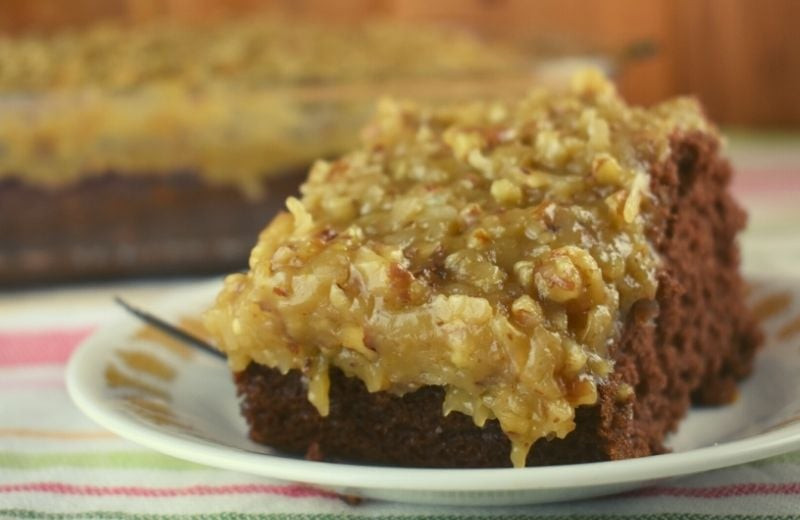
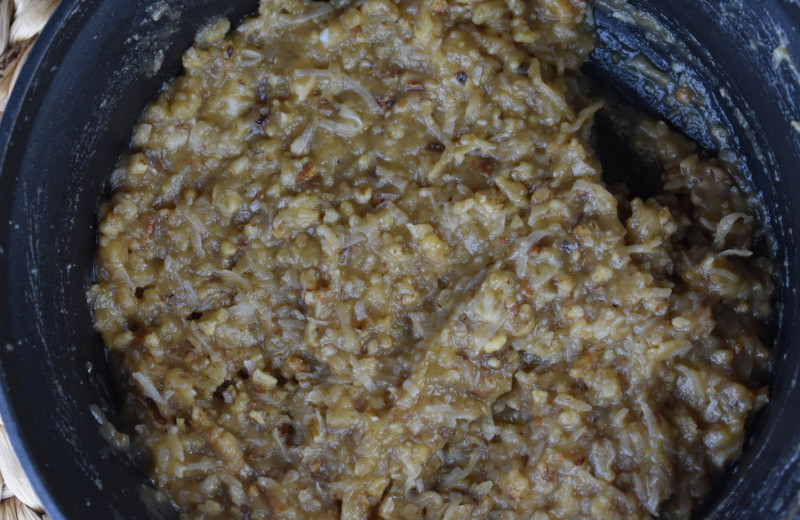
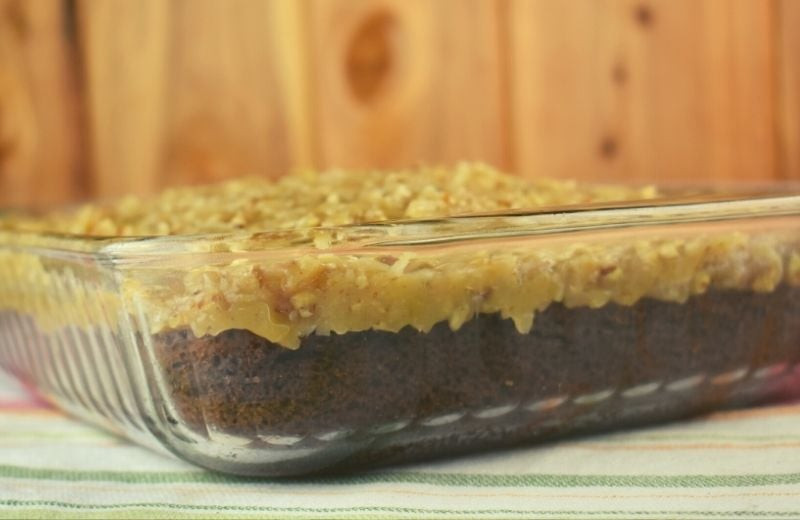
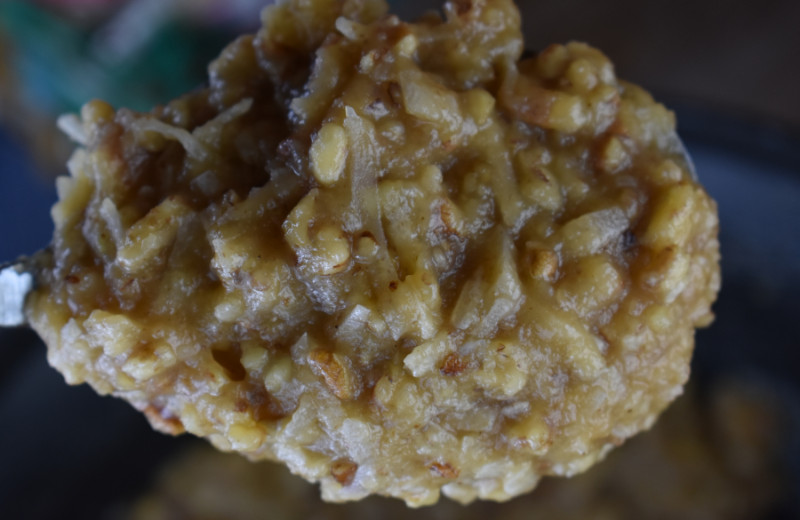
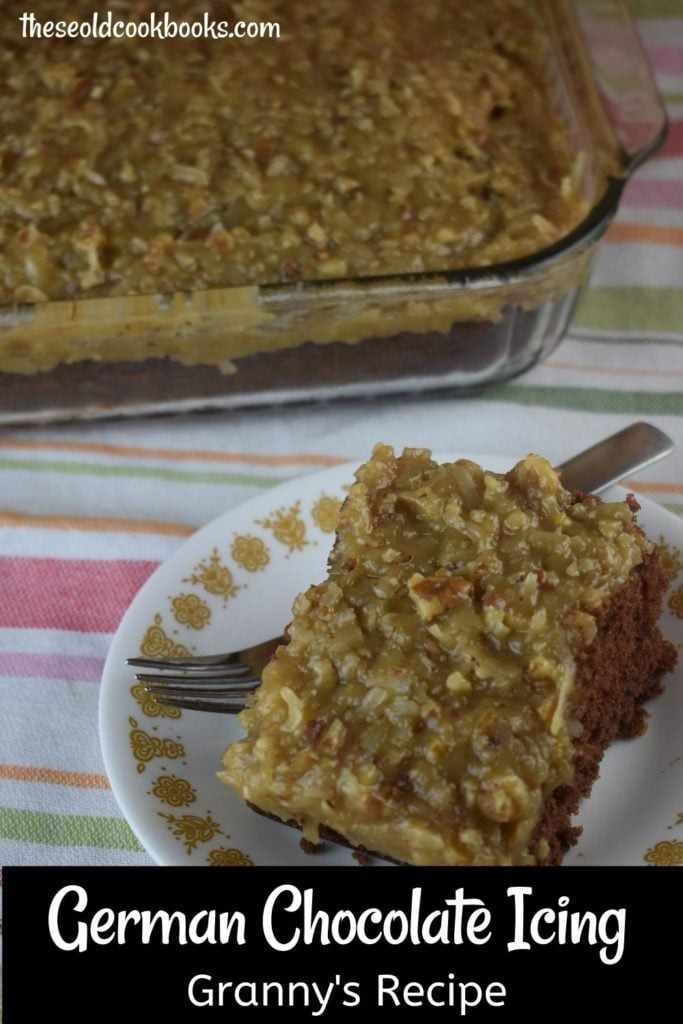
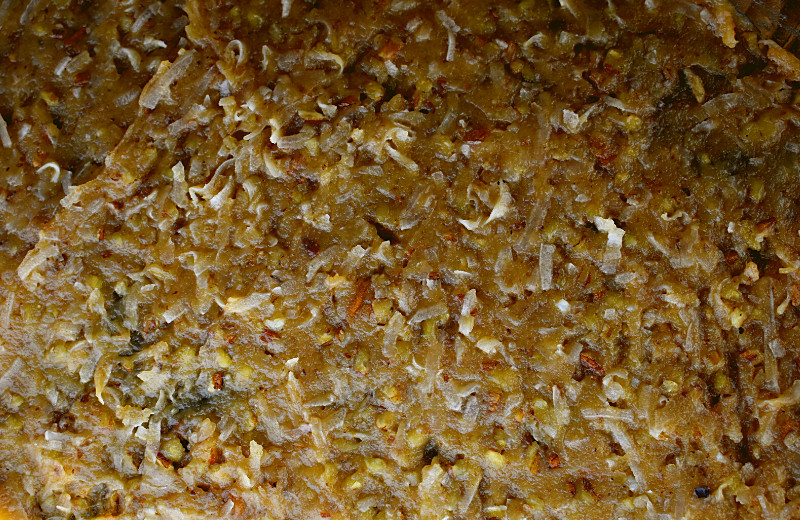
Understanding the importance of each ingredient is crucial for achieving the right balance and flavor in your icing. According to baking experts at the Culinary Institute of America, the quality of ingredients directly impacts the final product. Using high-quality, fresh ingredients will result in a richer, more flavorful icing that perfectly complements your German chocolate cake.
At mens-fashion.net, we believe that attention to detail matters, whether it’s in your wardrobe or your culinary creations. By selecting the best ingredients and understanding their roles, you’re not just making icing; you’re crafting an experience. Elevate your baking game and impress with the timeless elegance of old fashioned German chocolate cake icing, a true testament to refined taste.
3. How Do You Make Old Fashioned German Chocolate Cake Icing From Scratch?
Creating old fashioned German chocolate cake icing from scratch is a rewarding process that allows you to control every aspect of the flavor and texture. Follow these step-by-step instructions for a perfect homemade icing:
Ingredients:
- 1 cup evaporated milk
- 1 cup granulated sugar
- 3 large egg yolks
- ½ cup (1 stick) unsalted butter, cut into pieces
- 1 teaspoon vanilla extract
- 1 ⅓ cups sweetened shredded coconut
- 1 cup chopped pecans, toasted
Instructions:
- Combine Ingredients: In a medium saucepan, combine the evaporated milk, sugar, egg yolks, and butter.
- Cook Over Medium Heat: Place the saucepan over medium heat and cook, stirring constantly with a whisk.
- Stir Continuously: Continue stirring to prevent the mixture from sticking or scorching.
- Cook Until Thickened: Cook for about 10-12 minutes, or until the mixture thickens enough to coat the back of a spoon. It should have a light caramel color.
- Remove From Heat: Once thickened, remove the saucepan from the heat.
- Add Vanilla: Stir in the vanilla extract.
- Incorporate Coconut and Pecans: Add the shredded coconut and toasted pecans. Stir until evenly distributed.
- Cool Slightly: Let the icing cool slightly before spreading it on your cooled German chocolate cake layers. This will prevent the icing from running off the cake.
Here’s a detailed table breaking down each step:
| Step | Description | Tips & Notes |
|---|---|---|
| 1. Combine Ingredients | Mix evaporated milk, sugar, egg yolks, and butter in a saucepan. | Use a heavy-bottomed saucepan to prevent scorching. Ensure the butter is cut into pieces for even melting. |
| 2. Cook Over Medium Heat | Place the saucepan over medium heat. | Avoid high heat, as it can cause the eggs to curdle. |
| 3. Stir Continuously | Stir the mixture constantly with a whisk. | Pay close attention to the edges and bottom of the pan to prevent sticking. |
| 4. Cook Until Thickened | Cook for 10-12 minutes until the mixture thickens and coats the back of a spoon. | The mixture should be thick enough to leave a clear line when you run your finger across the back of the spoon. This is a sign that it’s ready. |
| 5. Remove From Heat | Take the saucepan off the heat. | This prevents overcooking, which can lead to a grainy texture. |
| 6. Add Vanilla | Stir in the vanilla extract. | Use pure vanilla extract for the best flavor. |
| 7. Incorporate Coconut and Pecans | Add the shredded coconut and toasted pecans. Stir until evenly distributed. | Toasting the pecans beforehand enhances their flavor. |
| 8. Cool Slightly | Let the icing cool slightly before spreading it on the cake. | This allows the icing to thicken further, making it easier to spread and preventing it from running off the cake. If it cools too much, it may become too thick to spread easily, so find the right balance. |
According to professional bakers at the Institute of Culinary Education, patience and constant stirring are key to achieving the perfect texture. Overcooking can result in a grainy icing, while undercooking will leave it too thin. The goal is to reach a smooth, creamy consistency that holds its shape.
At mens-fashion.net, we understand that precision and attention to detail are hallmarks of a stylish and successful man. Just as you meticulously curate your wardrobe, taking the time to master this classic icing recipe will elevate your culinary skills and impress your peers. Embrace the process, savor the results, and make a statement with your impeccable taste.
4. Can You Modify The Classic Recipe For German Chocolate Cake Icing?
Yes, the classic old fashioned German chocolate cake icing recipe can be modified to suit various tastes and dietary needs. Here are some popular modifications:
- Dairy-Free: Substitute the butter with a plant-based butter alternative and use coconut milk instead of evaporated milk. Ensure the plant-based butter has a high-fat content for a similar richness.
- Vegan: In addition to the dairy-free substitutions, replace the egg yolks with a cornstarch slurry (mix 2 tablespoons of cornstarch with 4 tablespoons of water). Add this slurry to the saucepan along with the other ingredients and cook as directed.
- Lower Sugar: Reduce the amount of granulated sugar or use a sugar substitute like stevia or erythritol. Be mindful that sugar substitutes may alter the texture and flavor slightly.
- Nut-Free: Omit the pecans entirely or replace them with toasted sunflower seeds or chopped dried cranberries for a similar textural element.
- Extra Rich: Use brown butter instead of regular butter for a deeper, nuttier flavor. Brown butter involves cooking the butter until the milk solids turn golden brown, enhancing its taste.
- Boozy: Add a tablespoon of rum or bourbon to the icing after removing it from the heat for an extra layer of flavor.
Here’s a table summarizing the modifications:
| Modification | Substitute/Addition | Notes |
|---|---|---|
| Dairy-Free | Plant-based butter, coconut milk | Use high-fat plant-based butter for richness; ensure coconut milk is full-fat. |
| Vegan | Plant-based butter, coconut milk, cornstarch slurry (2 tbsp cornstarch + 4 tbsp water) | Mix the cornstarch slurry thoroughly before adding to prevent lumps. |
| Lower Sugar | Stevia, erythritol, or reduced granulated sugar | Start with a small reduction and taste as you go; sugar substitutes may alter texture. |
| Nut-Free | Toasted sunflower seeds, chopped dried cranberries | Toast sunflower seeds for enhanced flavor; ensure cranberries are soft and moist. |
| Extra Rich | Brown butter | Cook butter over medium heat until milk solids turn golden brown, stirring constantly. |
| Boozy | Rum, bourbon | Add after removing from heat to preserve the alcohol flavor; use high-quality spirits for the best taste. |
According to chefs at the Natural Gourmet Institute, when making substitutions, it’s essential to consider how each ingredient contributes to the overall texture and flavor. For instance, when reducing sugar, you may need to add a touch of molasses or maple syrup to maintain moisture and depth of flavor.
At mens-fashion.net, we believe in adapting classics to fit your personal style and needs. Just as you tailor your wardrobe to reflect your individuality, modifying your German chocolate cake icing recipe allows you to create a dessert that is uniquely yours. Embrace these variations, experiment with flavors, and enjoy the process of making something truly special.
5. What Are The Best Tips For Perfecting Your Old Fashioned German Chocolate Cake Icing?
Perfecting old fashioned German chocolate cake icing requires attention to detail and a few key techniques. Here are some essential tips to ensure your icing turns out flawlessly:
- Use High-Quality Ingredients: The flavor of your icing will only be as good as the ingredients you use. Opt for fresh, high-quality butter, vanilla extract, and nuts.
- Toast Your Nuts: Toasting the pecans before adding them to the icing enhances their flavor and adds a pleasant crunch. Spread the pecans on a baking sheet and toast in a 350°F (175°C) oven for 5-7 minutes, or until fragrant.
- Stir Constantly: Constant stirring is crucial to prevent the icing from sticking to the bottom of the pan and scorching. Use a whisk to ensure even heating and a smooth consistency.
- Control The Heat: Use medium heat to cook the icing. High heat can cause the eggs to curdle and the mixture to become grainy.
- Watch For Thickness: The icing is ready when it’s thick enough to coat the back of a spoon. To test, dip a spoon into the mixture and run your finger across the back; if the line holds, the icing is ready.
- Cool Slightly Before Spreading: Allow the icing to cool slightly before spreading it on the cake. This will prevent it from running off the sides and help it adhere better.
- Don’t Overcook: Overcooking the icing can result in a dry, grainy texture. Remove the saucepan from the heat as soon as the icing reaches the desired thickness.
- Adjust Sweetness To Taste: Taste the icing as it cooks and adjust the amount of sugar to your preference. Keep in mind that the cake layers will also add sweetness to the overall dessert.
Here’s a table summarizing these tips:
| Tip | Description | Benefit |
|---|---|---|
| Use High-Quality Ingredients | Opt for fresh, high-quality butter, vanilla extract, and nuts. | Enhances the overall flavor and richness of the icing. |
| Toast Your Nuts | Toast the pecans before adding them to the icing. | Brings out the nutty flavor and adds a pleasant crunch. |
| Stir Constantly | Stir the mixture constantly with a whisk. | Prevents sticking, scorching, and ensures a smooth consistency. |
| Control The Heat | Use medium heat to cook the icing. | Prevents the eggs from curdling and the mixture from becoming grainy. |
| Watch For Thickness | Cook until the icing is thick enough to coat the back of a spoon. | Ensures the icing has the right consistency for spreading. |
| Cool Slightly | Allow the icing to cool slightly before spreading it on the cake. | Prevents the icing from running off the sides and helps it adhere better. |
| Don’t Overcook | Remove the saucepan from the heat as soon as the icing reaches the desired thickness. | Prevents a dry, grainy texture. |
| Adjust Sweetness | Taste the icing as it cooks and adjust the amount of sugar to your preference. | Allows you to customize the sweetness to your liking. |
According to seasoned pastry chefs at Le Cordon Bleu, mastering the art of making perfect icing is about understanding the science behind the ingredients and techniques. Paying attention to these details will ensure a smooth, creamy, and delicious icing that perfectly complements your German chocolate cake.
At mens-fashion.net, we believe that the pursuit of perfection is a worthwhile endeavor, whether it’s in your style, your career, or your culinary creations. By following these tips, you’ll elevate your baking skills and create an old fashioned German chocolate cake icing that is sure to impress. Embrace the challenge, refine your technique, and savor the sweet rewards of your efforts.
6. How Does Old Fashioned German Chocolate Cake Icing Compare To Modern Frostings?
Old fashioned German chocolate cake icing stands apart from modern frostings due to its unique ingredients, cooking process, and overall flavor profile. Here’s a detailed comparison:
| Feature | Old Fashioned German Chocolate Cake Icing | Modern Frostings (e.g., buttercream, cream cheese frosting) |
|---|---|---|
| Ingredients | Evaporated milk, egg yolks, butter, sugar, vanilla, shredded coconut, pecans | Butter or shortening, powdered sugar, milk or cream, flavorings (vanilla, chocolate, etc.) |
| Cooking Process | Cooked on the stovetop until thickened | Typically no cooking required; ingredients are mixed together |
| Texture | Slightly coarse due to coconut and pecans; rich and creamy | Smooth and creamy; texture can vary depending on the recipe and ingredients |
| Flavor | Deep, caramelized flavor with coconut and nutty notes; less sweet | Often sweeter, with a more pronounced butter or cream cheese flavor; can be easily flavored with extracts or cocoa |
| Stability | Less stable at room temperature due to the inclusion of dairy and eggs; requires refrigeration | More stable at room temperature due to higher fat content and lack of perishable ingredients |
| Preparation | Requires more time and attention due to the cooking process | Quick and easy to prepare; minimal effort required |
| Nostalgia | Evokes a sense of tradition and homemade goodness | Can be versatile and trendy, but may lack the nostalgic appeal of old fashioned recipes |
Here’s a more detailed look at the key differences:
- Ingredients and Flavor: Modern frostings often rely on butter or shortening and powdered sugar for a smooth, sweet taste. In contrast, old fashioned German chocolate cake icing uses evaporated milk, egg yolks, and less sugar, resulting in a richer, more complex flavor. The addition of coconut and pecans provides a distinctive taste and texture that sets it apart.
- Cooking Process: The cooking process is a significant differentiator. Modern frostings are typically made by simply mixing ingredients together, whereas old fashioned German chocolate cake icing requires cooking on the stovetop. This process caramelizes the sugars and thickens the mixture, creating a unique depth of flavor and texture.
- Texture and Stability: The texture of old fashioned German chocolate cake icing is slightly coarser due to the coconut and pecans. While this adds to its charm, it also means the icing is less stable at room temperature and requires refrigeration. Modern frostings, with their higher fat content, are more stable and can sit out for longer periods.
- Preparation Time: Making old fashioned German chocolate cake icing from scratch takes more time and attention than whipping up a batch of buttercream. The cooking process requires constant stirring and careful monitoring to prevent scorching or curdling.
According to culinary experts at the Good Housekeeping Institute, while modern frostings offer convenience and versatility, old fashioned German chocolate cake icing provides a unique flavor experience that is hard to replicate. Its rich, caramelized taste and distinctive texture make it a standout choice for those who appreciate traditional baking.
At mens-fashion.net, we appreciate the blend of classic and contemporary styles. While modern frostings have their place, there’s something special about the timeless elegance of old fashioned German chocolate cake icing. Just as a well-tailored suit exudes sophistication, this classic icing elevates your dessert to a new level of refinement. Embrace the tradition, master the technique, and impress with your impeccable taste.
7. How Should You Store German Chocolate Cake Icing?
Proper storage is crucial for maintaining the freshness and quality of your old fashioned German chocolate cake icing. Due to its dairy and egg content, this icing is more susceptible to spoilage than modern frostings made with higher fat content. Here’s a comprehensive guide:
- Refrigeration: Always refrigerate leftover German chocolate cake icing. Transfer the icing to an airtight container to prevent it from drying out and absorbing odors from the refrigerator.
- Cool Completely: Before refrigerating, allow the icing to cool completely to room temperature. This prevents condensation from forming inside the container, which can affect the texture and lead to spoilage.
- Airtight Container: Use an airtight container to store the icing. A well-sealed container will keep the icing fresh and prevent it from absorbing unwanted flavors and odors.
- Use Within a Week: For the best quality, use the refrigerated icing within one week. While it may still be safe to eat after a week, the flavor and texture may deteriorate.
- Freezing (Not Recommended): Freezing is not recommended for old fashioned German chocolate cake icing. The texture can change significantly upon thawing, becoming grainy and watery. If you must freeze it, be aware that the quality will be compromised.
Here’s a table summarizing these storage tips:
| Storage Method | Instructions | Notes |
|---|---|---|
| Refrigeration | Cool completely, transfer to an airtight container, and refrigerate. | Use within one week for best quality; prevents drying out and absorbing odors. |
| Freezing | Not recommended; if necessary, freeze in an airtight container. | Texture may change upon thawing, becoming grainy and watery; quality will be compromised. |
According to food safety experts at the USDA, proper refrigeration is essential for preventing the growth of bacteria in dairy and egg-based products. Keeping your German chocolate cake icing refrigerated at or below 40°F (4°C) will ensure it remains safe to consume.
At mens-fashion.net, we believe that attention to detail extends beyond your wardrobe to all aspects of your life, including food safety. Just as you take care to maintain your appearance, proper storage of your homemade icing is a sign of a refined and responsible individual. Follow these guidelines to ensure your old fashioned German chocolate cake icing remains fresh, delicious, and safe to enjoy.
8. What Common Mistakes Should You Avoid When Making German Chocolate Cake Icing?
Making old fashioned German chocolate cake icing can be a delightful experience, but it’s easy to stumble if you’re not aware of common pitfalls. Here are some mistakes to avoid:
- Not Stirring Constantly: One of the most common mistakes is failing to stir the icing constantly while it’s cooking. This can cause the mixture to stick to the bottom of the pan and scorch, resulting in a burnt flavor.
- Using High Heat: Cooking the icing over high heat can cause the eggs to curdle and the mixture to become grainy. Always use medium heat and monitor the temperature closely.
- Overcooking The Icing: Overcooking can lead to a dry, stiff icing that is difficult to spread. Remove the saucepan from the heat as soon as the icing reaches the desired thickness.
- Using Cold Ingredients: Using cold ingredients, particularly cold butter, can prevent the mixture from coming together smoothly. Ensure your ingredients are at room temperature before you begin.
- Adding Coconut and Pecans Too Early: Adding the coconut and pecans before the icing has thickened can cause them to become soggy. Wait until the icing is nearly ready before stirring them in.
- Skipping The Toasting Of Nuts: Neglecting to toast the pecans can result in a bland flavor. Toasting enhances their nutty taste and adds a pleasant crunch.
- Not Cooling The Icing Before Spreading: Spreading warm icing on a cake can cause it to melt and run off the sides. Allow the icing to cool slightly before applying it to the cake layers.
Here’s a table summarizing these common mistakes:
| Mistake | Consequence | Solution |
|---|---|---|
| Not Stirring Constantly | Scorched mixture, burnt flavor | Stir constantly with a whisk, paying attention to the bottom of the pan. |
| Using High Heat | Curdled eggs, grainy texture | Use medium heat and monitor the temperature closely. |
| Overcooking The Icing | Dry, stiff icing that is difficult to spread | Remove from heat as soon as the icing reaches the desired thickness. |
| Using Cold Ingredients | Mixture does not come together smoothly | Ensure ingredients are at room temperature before starting. |
| Adding Coconut and Pecans Too Early | Soggy coconut and pecans | Wait until the icing is nearly ready before stirring them in. |
| Skipping The Toasting Of Nuts | Bland flavor | Toast pecans in a 350°F (175°C) oven for 5-7 minutes before adding. |
| Not Cooling The Icing Before Spreading | Melting and running off the sides of the cake | Allow the icing to cool slightly before applying it to the cake layers. |
According to experienced bakers at King Arthur Baking Company, avoiding these common mistakes is key to achieving a smooth, creamy, and flavorful German chocolate cake icing. Paying attention to the details and following the recipe carefully will ensure a successful outcome.
At mens-fashion.net, we believe that attention to detail is what sets a stylish man apart from the crowd. Just as you take care to avoid fashion faux pas, being aware of these common mistakes will help you create a flawless old fashioned German chocolate cake icing that is sure to impress. Embrace the learning process, refine your technique, and enjoy the sweet rewards of your efforts.
9. Can You Use Old Fashioned German Chocolate Cake Icing For Other Desserts?
Yes, old fashioned German chocolate cake icing is incredibly versatile and can be used for a variety of desserts beyond the classic German chocolate cake. Here are some creative ways to incorporate this delicious icing into other treats:
- Cupcakes: Top chocolate or vanilla cupcakes with German chocolate cake icing for an extra special treat. The combination of the moist cupcake and the rich, nutty icing is irresistible.
- Brownies: Spread German chocolate cake icing over a batch of freshly baked brownies for a decadent dessert. The icing adds a layer of creamy sweetness that complements the fudgy texture of the brownies.
- Cookies: Use German chocolate cake icing as a filling for sandwich cookies or as a topping for sugar cookies. The unique flavor and texture of the icing will elevate your cookies to a new level.
- Cinnamon Rolls: Spread German chocolate cake icing over warm cinnamon rolls instead of traditional cream cheese frosting. The coconut and pecans add a delightful twist to this classic breakfast treat.
- Pancakes or Waffles: Top your pancakes or waffles with a dollop of German chocolate cake icing for a weekend brunch indulgence. The warm icing will melt slightly, creating a luscious sauce.
- Fruit Dip: Serve German chocolate cake icing as a dip for fresh fruit like strawberries, bananas, and apple slices. The creamy, nutty flavor of the icing pairs perfectly with the sweetness of the fruit.
- Ice Cream Topping: Drizzle German chocolate cake icing over your favorite ice cream for a decadent sundae. The icing adds a rich, flavorful topping that takes your ice cream to the next level.
Here’s a table summarizing these creative uses:
| Dessert | How To Use German Chocolate Cake Icing | Notes |
|---|---|---|
| Cupcakes | Top chocolate or vanilla cupcakes with the icing. | Adds a rich, nutty flavor to complement the cupcakes. |
| Brownies | Spread the icing over freshly baked brownies. | Creates a decadent dessert with a creamy, sweet topping. |
| Cookies | Use as a filling for sandwich cookies or a topping for sugar cookies. | Elevates the flavor and texture of your cookies. |
| Cinnamon Rolls | Spread over warm cinnamon rolls instead of cream cheese frosting. | Adds a unique twist to a classic breakfast treat. |
| Pancakes/Waffles | Top pancakes or waffles with a dollop of the icing. | Creates a luscious sauce as the warm icing melts slightly. |
| Fruit Dip | Serve as a dip for fresh fruit like strawberries, bananas, and apple slices. | Pairs perfectly with the sweetness of the fruit. |
| Ice Cream | Drizzle over your favorite ice cream for a decadent sundae. | Adds a rich, flavorful topping that takes your ice cream to the next level. |
According to pastry chefs at the Buttercup Bakeshop, the key to using German chocolate cake icing in other desserts is to consider how its unique flavor and texture will complement the other ingredients. Experiment with different combinations and don’t be afraid to get creative.
At mens-fashion.net, we believe that a stylish man is not afraid to experiment and express his creativity. Just as you mix and match different pieces of clothing to create your own unique look, you can use old fashioned German chocolate cake icing in a variety of desserts to showcase your culinary skills and impress your friends and family. Embrace the versatility of this classic icing and enjoy the delicious results.
10. What Are Some Interesting Facts About German Chocolate Cake and Its Icing?
German chocolate cake and its iconic icing have a rich history and several interesting facts that add to their appeal. Here are some fun tidbits:
- It’s Not German: Despite its name, German chocolate cake is not from Germany. The name comes from Samuel German, an American baker who developed a type of dark baking chocolate in 1852 for the Baker Chocolate Company.
- The Original Recipe: The recipe for German chocolate cake as we know it today first appeared in a Dallas newspaper in 1957. It was created by a home baker and featured German’s sweet chocolate in the cake batter.
- The Icing’s Rise To Fame: The coconut-pecan icing became popular shortly after the cake recipe was published. It was a perfect complement to the mild chocolate flavor of the cake.
- Baker’s Chocolate: Baker’s German’s Sweet Chocolate is a key ingredient in the cake, providing a distinct flavor that is less intense than other types of dark chocolate.
- Regional Variations: While the classic German chocolate cake is well-known, there are regional variations. Some recipes include sour cream in the batter for added moisture, while others use different types of nuts in the icing.
- National German Chocolate Cake Day: In the United States, National German Chocolate Cake Day is celebrated on March 15th each year, giving people an excuse to indulge in this classic dessert.
- Popularity Surge: The cake’s popularity surged in the 1960s, cementing its place as a staple in American baking.
Here’s a table summarizing these interesting facts:
| Fact | Description | Significance |
|---|---|---|
| Not German | The cake is named after Samuel German, an American baker, not the country Germany. | Highlights the American origin of the cake despite its misleading name. |
| Original Recipe | The recipe first appeared in a Dallas newspaper in 1957. | Marks the beginning of the cake’s widespread popularity. |
| Icing’s Rise To Fame | The coconut-pecan icing quickly became a perfect complement to the cake. | Showcases how the icing became an integral part of the German chocolate cake experience. |
| Baker’s Chocolate | Baker’s German’s Sweet Chocolate is a key ingredient. | Provides the cake with a distinct, mild chocolate flavor. |
| Regional Variations | Variations exist with sour cream in the batter or different nuts in the icing. | Demonstrates the adaptability of the recipe to suit local tastes. |
| National German Chocolate Cake Day | Celebrated on March 15th each year in the United States. | Provides an annual opportunity to celebrate and enjoy this classic dessert. |
| Popularity Surge | The cake’s popularity surged in the 1960s. | Solidified its status as a staple in American baking. |
According to food historians at the Smithsonian Institution, the story of German chocolate cake is a fascinating example of how a simple recipe can evolve and become a cultural icon. Its unique combination of flavors and its association with American baking traditions have made it a beloved dessert for generations.
At mens-fashion.net, we believe that knowing the history and background of classic dishes adds to their appeal. Just as understanding the origins of a timeless fashion piece enhances its value, knowing these interesting facts about German chocolate cake and its icing makes enjoying it even more special. Embrace the tradition, appreciate the history, and savor the deliciousness of this iconic dessert.
Ready to elevate your baking game and impress with your impeccable taste? Visit mens-fashion.net for more tips, tricks, and recipes to enhance your lifestyle and make a statement. Explore our collection of articles and discover how to blend classic traditions with modern flair, both in your wardrobe and in your kitchen.
FAQ: Old Fashioned German Chocolate Cake Icing
1. What is old fashioned German chocolate cake icing made of?
Old fashioned German chocolate cake icing is traditionally made with evaporated milk, granulated sugar, egg yolks, butter (or margarine), vanilla extract, shredded coconut, and pecans.
2. Why is it called German chocolate cake icing if it’s not from Germany?
The name “German” comes from Samuel German, an American baker who developed a type of dark baking chocolate for the Baker Chocolate Company.
3. How do you thicken German chocolate cake icing?
To thicken the icing, cook it
